Submitted by ETC Staff on
INTRODUCTION
This is RAFI's second annual report on the life industry. Spurred by trends in globalization, technology and privatization, the inputs and outputs used in commercial agriculture, food and health are increasingly concentrated in the hands of giant, transnational enterprises - the "life industry."
If it's a product used on (or produced by) a commercial farm, if it's in your medicine cabinet or in your refrigerator, chances are very good that it was bought or sold by at least one of the life industry firms profiled in this RAFI Communique.
A look at the internal structure of one life industry enterprise, Novartis (formed by the 1995 merger of Ciba Geigy and Sandoz), illustrates global reach into every aspect of commercial agriculture, food and health. Novartis currently ranks as the world's largest agrochemical corporation, the number two seed/plant breeding firm, the number three pharmaceutical corporation, and the ninth ranking animal pharmaceutical corporation. Through both strategic alliances and buy-outs, Novartis is also a major player in human genomics. With three major corporate divisions: agribusiness, healthcare and nutrition, Novartis spans the businesses of life and epitomizes the life industry.
GLOBAL MERGER MANIA
Consolidation is taking place in all sectors of the global economy. The volume of mergers and acquisitions set an all-time high in 1996. But 1997 deals have already shattered last year's record. As of November 1, 1997 mergers and acquisitions involving US companies alone exceeded $744 billion - far surpassing the 1996 figure of $648 billion.2 While most deals are struck in the industrial North, consolidation is a global phenomenon. According to the United Nations Conference on Trade and Development (UNCTAD) global mergers and acquisitions accounted for a record $275 billion, or 79% of all global foreign direct investment in 1996.3
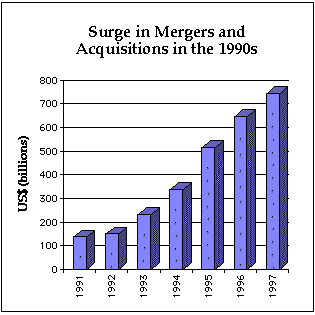
In other words, four-fifths of the cross-border investment worldwide resulted from mergers and takeovers. Cross-border investment in South nations rose last year by one-third to a new record of US $129 billion (37% of the total world inflows). A total of 45 mergers and acquisitions monitored by UNCTAD in 1996 - most of them in the South - were worth more than $1 billion. UNCTAD estimates that 44,000 TNEs worldwide, with about 280,000 foreign subsidiaries, had assets worth $3.2 trillion in 1996. As the pace of consolidation accelerates, however, a greater proportion of those assets are held by fewer and fewer transnational enterprises.
European mergers and acquisitions hit a record (US) $400.6 billion in 1996 - just over half the volume of deals in the US but double the European level just two years ago.4 Even before the end of 1997, the value of European mergers and acquisitions has far exceeded last year's. On October 13, Western Europe saw $130 billion worth of takeovers and mergers in a single day.5 The Economist magazine notes, "Henceforth, there can scarcely be a single banker, insurer or industrialist in Western Europe who will not be pondering nervously which new firm he needs to acquire - or which firm may acquire his."6
The surge in mergers and takeovers is taking place with fewer, larger deals. With fewer competitors remaining, the US defense industry reached the point of "complete consolidation" in 1997.7 Raytheon acquired the defense holdings of Texas Instruments for $2.95 billion and of Hughes Electronic Corp. for $9 billion. In July, Lockheed Martin and Northrop announced a $8.26 billion merger. Only three giants survive: Raytheon, Lockheed Martin and Boeing Co.
Will the life industry follow suit? They may be Lords of Life, but they're not immortal. Further consolidation is on the way. According to industry analysts, by the year 2010 about one-third of all the companies featured on Fortune Magazine's list of the largest industrial enterprises will have merged, divested or gone bust.8 The life expectancy of the average European and Japanese company is less than 13 years.9
In the following pages RAFI offers information and analysis on the top 10 enterprises in 5 life industry sectors: seeds, agrochemicals, pharmaceuticals, food and veterinary medicine.
SEEDS AND AGROCHEMICALS
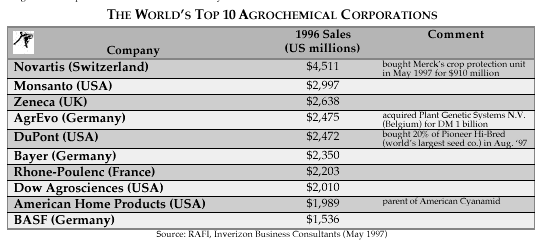
Agrochemical and Seed Industry Alliances Fortified in 1997
RAFI has been monitoring dramatic changes in the seed industry for two decades. Commercial plant breeding and seed sales are no longer the domain of small breeders and regional companies, now they are clearly dominated by agrochemical/ pharmaceutical companies. This long term trend continued during the past year.
The top 10 seed companies control about 40% of the global commercial seed market, valued at approximately (US) $15 billion. The top 10 agrochemical corporations accounted for $25.1 billion, or 82% of all agrochemical sales in 1996. Global agrochemical sales were US $30.5 billion in 1996, up more than 15% since 1994.
Over the past 18 months, Monsanto has invested nearly $2 billion in seed company and related acquisitions.10 In November, 1997 Monsanto acquired a major tropical germplasm base with the acquisition of Brazil's Sementes Agroceres - giving Monsanto an estimated 30% market share in the Brazilian maize seed market. In January, 1997 Monsanto took a giant bite out of the hybrid maize seed market with the (US) $1.2 billion acquisition of Holdens Foundation Seeds. An estimated 25-35% of the maize acreage planted in the US is based on germplasm developed by Holdens. According to industry analyst Dain Bosworth, Monsanto's goal is to get its bioengineered seed products on at least half of the 40 million maize acres that Monsanto now has gained access to by acquiring major seed companies.11
Monsanto isn't the only life industry heavyweight consolidating the maize market. In August 1997, DuPont (US) acquired 20% of Pioneer Hi-Bred, the world's largest seed company, for $1.7 billion. The two companies will jointly invest $400 million in a agricultural research effort and form a new company, Optimum Quality Grains.
STAKING CLAIM ON CROP GENOMES
AGRIBIOTECH - Seed Consolidation King
AgriBiotech, a US-based seed company founded in 1995, has developed an insatiable appetite for devouring US-based turf and forage seed companies. The company's goal is to achieve 45% market share in forage and turfgrass by the year 2000. AgriBiotech has made 14 acquisitions since 1995 - with more pending. The company's annual sales have shot up from $4.7 million in 1995, to $230 million in expected revenues for 1997.12 The company says that its takeovers would not have been possible without changes in US plant breeders rights and patenting laws that put limits on farmers' ability to save and re-sell proprietary seed. Some of AgriBiotech's acquisitions (and their subsidiaries) include:
Olsen-Fennell, W-L Research, Burlingham, Germains, Clark Seeds, Lofts Seed, Great Western, Green Seed, Sunbelt, Budd, Sexauer, Halsey Seed, Seed Mart Inc., Arnold-Thomas, Hobart Seed, Beachley-Hardy, Seed Resource Inc., Sphar Seed, Scott Seed Co., Seed Corp of America, Seed Resource, and Seedbiotics Seed and Agrochemical Firms Forge Alliances with Human Genomic Companies
Many of the leading plant breeding and seed company enterprises are turning to "advanced genomics" as a means of identifying, mapping and gaining control over key crop genes, and agronomically important traits. To identify and map crop genes, leading life industry enterprises are turning to the experts: the "gene boutique" companies that are best known for mapping (and patenting) human genes.
Pioneer Hi-Bred launched a $16 million maize genomics program with Human Genome Sciences Inc. in 1996 that has already generated 80,000 gene tags.13 Pioneer has reportedly discovered a number of genes in its proprietary maize strains that may affect economically important traits in maize. According to Pioneer spokesperson, Tony Cavalieri, "We're being fairly aggressive in filing for patents on genes we discover."14 Monsanto initiated a plant genomic partnership in 1996 with a leading human genomic company, California-based Incyte "to generate sequence and expression data from certain plant species, including corn."15
In October, 1997 Monsanto and Millennium Pharmaceuticals (a US-based genomic company) announced a 5-year collaborative agreement worth over $118 million, including the creation of a new Monsanto subsidiary with about 100 scientists to work exclusively with Millenium to use genomic technologies. The exclusive agreement is not limited to a single crop or geographic location - it covers all crop plants in all countries. Monsanto considers the new subsidiary "an integral part of its life sciences strategy" and hopes to gain a competitive edge in the search for patentable crop genes.16
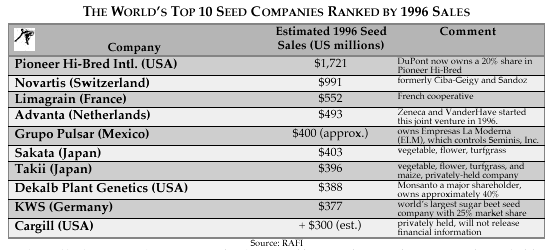
Limagrain, the world's third largest seed company, is reportedly "heavily involved" in advanced genomic research, but few details are available.17
PLANT, PLASTIC OR PILL?
In today's life industry, the common denominator is the use of proprietary genetic materials and technologies as the raw materials for producing industrial products. A single company can thus span pharmaceuticals, crop chemicals, plant and animal breeding, veterinary medicines and even food processing.
The lines are getting fuzzier. Take for instance "plantibodies," human antibodies purified and extracted from a genetically engineered maize variety. Agracetus, a biotechnology subsidiary of Monsanto, took its first crop of human antibodies manufactured in maize to clinical trials in 1997.
"Genomics hold many promises: A doctor may one day diagnose the genetic cause of a disease and cure it instead of treating symptoms; a life sciences company may discover new components for foods that could help prevent that disease; and a farmer could even grow the cure for it in his cornfield."
- Monsanto's 1996 Annual Report.
Agracetus scientist Vikram Paradkar told Scientific American, "We could grow enough antibodies to supply the entire US market for our cancer drug - tens of thousands of patients - on just 30 acres."18 Agracetus is also cultivating soybeans that contain human antibodies against a herpes virus associated with venereal disease.
Life industry enterprises are also forging alliances to take advantage of separate strengths. In November, 1997 Dow Chemical and Cargill announced a new joint venture company, Cargill Dow Polymers, that will manufacture biodegradeable plastics from corn and sugar beets.19
TECHNOLOGY WINNERS AND LOSERS
Control of Patented Gene Traits
As a new generation of transgenic crops becomes commercially available, industry observers predict that ownership and control of patented gene traits in plants (i.e. insect tolerance, herbicide tolerance, improved protein quality, enhanced oil production, etc.) will determine which companies and public sector institutions survive and which will have access to new technologies.20 Until now, most of the transgenic crops sold commercially were engineered for single gene traits (primarily herbicide tolerance or insect resistance). In 1997, life industry corporations began marketing crops with "stacked gene traits" - that is, combining more than one engineered trait in a single variety. Garst Seeds (a subsidiary of Advanta), for example, offered a maize hybrid that tolerates two different classes of chemical herbicides. Other bioengineered seeds will combine traits for herbicide tolerance with insect resistance, and gray leaf spot resistance with high soil pH tolerance.21
All of these traits are the subject of monopoly patents, and industry observers predict the emergence of a global "trait market" for proprietary technologies at the molecular level. A report released in April by the private sector committee of the Consultative Group on International Agricultural Research (CGIAR) candidly advises public sector agricultural researchers (especially in the South) of their limited options:
"The string of protections associated with a germplasm is leading to the emergence of a complex set of intellectual property rights claims (IPR pedigree) and imposition of legal bariers that limit the researchers' "freedom to operate." Any IPR holder of even one element could block the commercialization of an insect-tolerant variety based on this package of technologies...Freedom to operate will become even more complicated as companies seek to bundle traits to gain competitive advantage."22
The CGIAR Private Sector Committee reasons that public sector researchers will be forced to enter partnerships with the private sector or risk losing access to technologies that are legally restricted by a complex pedigree of patented gene traits. The life industry's control of patented genes and traits has already created legal barriers, which could make it vitually impossible for small companies or public sector researchers to compete, or gain access to new agricultural technologies, unless they have something to bargain or trade in exchange.
In essence, the life industry enterprises that control patented traits hold an enormously powerful bargaining position: They are now attempting to convince the CGIAR's international agricultural research centers (IARCs) that they "will be able to participate in this market more effectively if they have a cache of `trading chips' in the form of traits generated through their own research."23 This requires recognizing and strengthening intellectual property regimes because they are "in the long-term interest of both the local and international private sectors." In the end, however, the partnership envisioned by the private sector is not a partnership of equals. The terms of access will be determined by the most powerful "partner" - the life industry. In RAFI's view, the industrial intellectual property system is scale-biased and fundamentally inequitable. It does not offer a level playing field on which public and private sectors, North and South, can participate as equal partners and is undermining public sector research.
The food and beverage sector clearly dominates the life industry. The 1996 sales of a single food industry giant, Nestle, are nearly 3 times the value of the commercial seed industry! At first glance it may appear that the food and beverage corporations are stand-alone giants with little connection to the other life industry sectors. In reality, diversified food corporations are increasingly active in other fields of life science. Though Swiss-based Nestle is known primarily as the world's largest food company, it also ranks 50th in global pharmaceutical sales.24 (4% of Nestle's revenues comes from pharmaceuticals.)
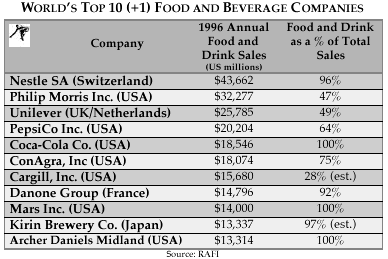
This year's single largest European merger (as of October, 1997) was the $18.2 billion marriage of Guinness (UK) and Grand Metropolitan (UK) to create GMG Brands, which will become the seventh largest food and drink company in the world. Archer Daniels Midland (ADM), the 11th largest food and beverage corporation, recently acquired the cocoa businesses of W.R. Grace and ED & F Mann, takeovers that give ADM 16 chocolate plants in Europe and the Americas. The company claims it is now the world's largest player in the cocoa business.25
ANIMAL HEALTH
Animal Pharmaceutical Industry
The pace of consolidation in the animal pharmaceutical (animal health) business over the past decade probably exceeds that of any other life industry sector. In 1980, the top 10 companies held 30% of the total worldwide market; in 1995 the top 10 companies held 56% of the market; today the top 10 control an estimated 63% of the $16 billion market.

What's the forecast for 1998? "There's going to be more consolidation, pure and simple," predict industry analysts.26 According to Fountain Agricounsel, another 10 companies will be targets of mergers, joint venture or divestment simply because they can't compete against "$1 billion, research-based gorillas with full global reach."27
None of the top 10 animal pharmaceutical companies are stand-alone enterprises devoted solely to veterinary medicine. The profit margins for human proprietary drugs are at least 50% higher than for animal drugs, so it's not surprising that all of the top companies are tied to major pharmaceutical/ agrochemical concerns.28
Twenty percent ($3.3billion) of the entire animal pharmaceutical market is devoted to "companion animals" - or pets. This segment currently has the highest margins and growth potential. (A survey of North American veterinarians recently found that the average pet owner is willing to spend $575 in medical costs before allowing his/her pet to die.)
PHARMACEUTICAL INDUSTRY
The world pharmaceutical market is valued at (US) $251 billion dollars per annum.29 The top 10 companies account for approximately 36% of the global market.
VERTICAL INTEGRATION CONTINUES
In 1996-1997, the global pharmaceutical industry reveled in near-record profit margins and double-digit growth figures. In 1996, pharmaceutical sales in North America grew at a rate of 9% over 1995, and 7% worldwide. In the third quarter of 1997, pharmaceutical product sales rose 16% worldwide.30 In comparison with the mega-mergers of the past several years, merger activity has lagged in 1996-97. Only two major actions took place: Roche Holding Ltd. acquired Corange Ltd. and Amersham International merged with Nycomed. Though mergers and acquisitions have slowed temporarily, "vertical integration" is a notable trend, particularly in North America, which accounts for 33% of the $251 billion global market.
Since 1993, Merck, Eli Lilly and SmithKline Beecham have spent (US) $12.9 billion to purchase the three largest "pharmacy benefit management" (PBM) companies in the US (see RAFI Communique, The Life Industry, September, 1996). PBMs are the firms that manage the prescription drugs for health insurance plans - covering a growing percentage of the American population. In 1996, the dollar volume of the managed care segment of the prescription drug market grew by 23%, and its dollar share of the total prescription market climbed to 71%, up from 65% in 1995.31
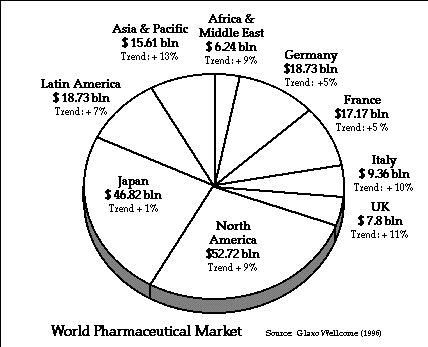
The PBMs maintain preferred lists of prescription drugs for insurance company patients, and thus represent powerful "middlemen" between the drug company and consumer. Beginning in the early 1990s, the pharmaceutical industry discovered how to control the middlemen: "They decided that if they couldn't beat them, they would buy them," explains Stephen Schondelmeyer, professor of pharmaceutical economics at the University of Minnesota.32 The end result, according to Money magazine, is that "the drugs you can get your insurer to pay for is narrowing -- and tilting evermore toward specific drugmakers' products."33 New vertical alliances between the drug industry and healthcare firms are springing up. Drug companies are crafting multimillion dollar deals in which they simply pay PBMs to promote their products. Johnson & Johnson and Novartis for example, have contracts with Value Rx (27 million members), while Bristol-Myers Squibb and Pfizer have similar agreements with Caremark (15 million members)34.
THE BUSINESS OF CANCER
In April, 1997 British-based Zeneca, the world's second-largest manufacturer of cancer drugs, announced that it was taking over the management of 11 cancer research centers in the United States. Industry analysts say its the first time that a maker of drugs actually oversees their prescription. According to the New York Times: "In recent years, pharmaceutical companies have branched out, owning drug distribution companies and home health care agencies. But never before has a company employed doctors who can prescribe its drugs."35 In understated candor, Arthur Caplan, a University of Pennsylvania bioethicist told the New York Times, "Having your doctor, your clinic, your pharmacy and your testing lab all owned by the same person is not the optimal structure for health care."36
THE HUMAN GENOMIC INDUSTRY
From Gene Boutique to Life Industry Power
Visitors to California-based Sequana Therapeutics are often greeted by the company CEO, Kevin Kinsella, who hands out a glossy compact disc.37 The disc case is inscribed with the individual's name, a DNA double helix, and the words of the Delphic oracle: "Know thyself." Within a few years, Kinsella told The Economist, you will be able to hold up a compact disc and say: "That's me."38 There's no doubt that the genetic blueprint of a single individual will someday be stored on a single disc, or "biochip." The more pressing question is: Who will own the information? And who will control the genes and technologies that may someday provide critical tools for diagnosing and treating human diseases? Based on current trends, there's little doubt that the life industry giants are most likely to finish first in "the human gene race."
RAFI has been monitoring alliances between human genomic companies and the pharmaceutical industry since 1994. Some observers predict that as much as 50% of all pharmaceutical industry research will be genome-based by the year 2000.39 As a result, drug company alliances, equity investments and and buyouts of human genomic companies are accelerating. The following are just a few examples:" "
FOLLOW THE MONEY
AFFYMETRIX, INC. - Glaxo Wellcome owns approximately 33% of Affymetrix as of Dec. 1996.
DARWIN MOLECULAR CORP. - Chiroscience Ltd. (Cambridge, UK) acquires Darwin for $120 million in November, 1996.
GENOME THERAPEUTICS CORP. - Sells exclusive access to its sequencing of Heliobacter pylori (bacterium) genome to Astra AB for up to $22 million.
HUMAN GENOME SCIENCES - According to HGS, "Our computers hold data we believe describes more than 95% of all human genes."40 HGS has agreements totalling more that $250 million with Merck, SmithKline Beecham, Schering-Plough, Synthelabo and Takeda.
INCYTE, INC. - Eleven major drug companies now subscribe to Incyte's proprietary gene sequence database. Incyte claims to process more than 10,000 gene sequences per day and have sequenced more than 2.5 million gene fragments.
MERCATOR GENETICS, INC. - Acquired by Progenitor, Inc. in early 1997 for $30 million.
MILLENNIUM PHARMACEUTICALS, INC. - Merged with ChemGenics in January, 1997. Millennium has seven alliances with five major pharmaceutical partners providing over $300 million in funds.
MYRIAD GENETICS, INC. - Bayer, Eli Lilly, Novartis, Pfizer and American Home Products have alliances with Myriad. In November, 1997 Bayer made $54 million deal with Myriad to identify genes for brain disorder. _ Sequana Therapeutics - In October 1997 Arris Pharmaceuticals acquired Sequana for $166 million. The company's new name is Axys Pharmaceuticals. Axys holds more than 30,000 human DNA samples, and has agreements with Glaxo, Boehringer Ingelheim, Roche, Novo Nordisk, Perkin-Elmer for discoversy of human disease genes.
ARIAD PHARMACEUTICALS, INC. - Hoechst and ARIAD commit $85 million to establish joint venture in genomics, Hoechst-ARIAD Genomics Center.
------------------------------------------------------------------------
1 Office of Technology Assessment, "Multinationals and the US Technology Base", Washington, 1994, p.1.
2 Personal communication with Richard Peterson of Securities Data, New York.
3 UNCTAD Press Release, "Continued Upswing of Global FDI in 1996," 10 July 1997: www.unicc.org/unctad/en/pressref/pr2710en.htm
4 Edmund L. Andrews,, "High Noon in Europe: Big Wall St. Banks Gallop in, Guns Ablaze,"in New York Times, July 13, 1997.
5 "Merger Monday," The Economist, October 28, 1997, p. 61.
6 The Economist, October 28, 1997, p. 61.
7 Bruce Balestier, "Billion-Dollar Deals: Consolidation, Strategic Planning Drive Activity, New York Law Journal, August 14, 1997.
8 "Management Focus: How to Live Long and Prosper," in The Economist, May 10, 1997, p. 59.
9 The Economist, May 10, 1997, p. 59.
10 Andrew Marshall, "Millenium signs away plant kingdom to Monsanto," Nature Biotechnology, Vol. 15, December, 1997, p. 1334.
11 Dain Bosworth, "Seed Industry Overview," April 7, 1997, p. 24.
12 Business Wire, September 24, 1997.
13 "Pioneer Hi-Bred Mines its Corn Gene Pool," Genetic Technology News, April, 1997, p.5.
14 Natalie S. Knudsen, "Pioneer Invests in Genome Research for the Future," Seeds & Crops Digest, June/July, 1997, p. 35.
15 Incyte Press Release, "Incyte and Monsanto Enter into Plant Genomics Partnership," September 17, 1996.
16 Andrew Marshall, "Millennium signs away plant kingdom to Monsanto," Nature Biotechnology, Vol. 15, Dec. 1997, p. 1334.
17 Bill Freiberg, "Groupe Limagrain: Diversifying into New Scientific opportunities," Seed & Crops Digest, June/July, 1997, p. 21.
18 "Plantibodies," Scientific American, November, 1997.
19 SCI Electronic Publication, News Alert, 28 November 1997. On the internet at: http://sci.mond.org/pubs.html
20 Suri Sehgal, "IPR Driven Restructuring of the Seed Industry," Biotechnology and Development Monitor, No. 29, December, 1996, p. 19-21. Sehgal is an employee of Plant Genetic Systems (AgrEvo), and a member of the Private Sector Committee of CGIAR.
21 Greg D. Horstmeier, "What's Next for Designer Seeds?", Farm Journal, January, 1997.
22 Strengthening CGIAR - Private Sector Partnerships in Biotechnology: A Private Sector Committee Perspective on Compelling Issues, CGIAR Private Sector Committee, April 30, 1997, p. 4.
23 CGIAR Private Sector Committee Report, p. 3.
24 Med Ad News, September, 1997, p. 4.
25 Feedstuffs, "ADM building global strength for next century's challenge" October 20, 1997.
26 Robert Fountain and Duane Thurman, Feedstuffs, December 1, 1997.
27 ibid.
28 ibid.
29 According to Glaxo Wellcome data in Med Ad News, Sept. 1997, p. 6.
30 Matthew Lerner, Chemical Market Reporter, November 3, 1997, p. 18.
31 "Annual Report on the Top 50 Pharmaceutical Companies."MedAd News, September, 1997. As defined by MedAd New, health care revenues include human prescription and non-prescription pharmaceuticals, medical devices and equipment, raw pharmaceutical chemicals, diagnostics, and animal health care products.
32 Peter Keating, "The Wrong Medicine," Money, June, 1997.
33 ibid.
34 ibid.
35 Elizabeth Rosenthal, "Maker of Cancer Drugs to Oversee Prescriptions at 11 Cancer Clinics," New York Times, April 15, 1997
36 ibid.
37 Sequana Therapeutics was recently acquired by Arris Pharmaceuticals, and is now known as Axys Pharmaceuticals. Kinsella is no longer CEO.
38 "Genes and T-shirts," The Economist, January 4, 1997.
39 McKusick, Victor A., "DNA Sampling: What Would Osler Say?", Keynote Address, First International Conference on DNA Sampling - Human Genetic Research: Ethical, Legal and Policy Aspects, September, 1996, Montreal, Quebec, Canada.
40 Human Genome Sciences, Inc., 1996 Annual Report, p. 6."
